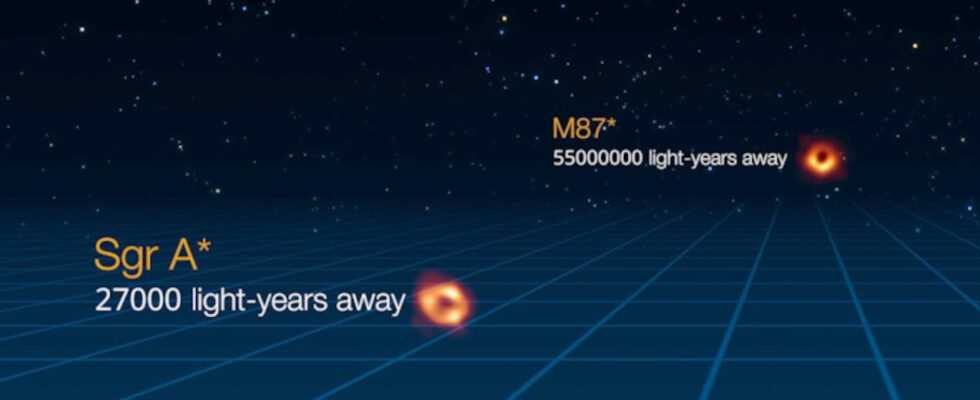Sagittarius A*, M87*, M31*… Several black holes have in common the presence of an asterisk at the end of their name. Where does this feature come from, which does not concern all black holes?
Finally, we know what the supermassive black hole at the center of the Milky Way looks like. On May 12, 2022, the first photo of this astronomical object was presented (and no, this black hole photo is not “blurry”). We do not “see” exactly the black hole, which is by definition invisible. But it’s him, that shadow in the center of the image, surrounded by a bright ring of gas. This shadow is called Sagittarius A*.
This name, which may seem atypical, refers to the constellation Sagittarius, in which a source of radio waves associated with the black hole, Sagittarius A, is located. But why add an asterisk to designate the black hole? However, there is no rule that all astronomers should follow when naming these fascinating celestial objects. ” Official nomenclatures are set by the International Astronomical Union (IAU). For black holes, there is no specific rule “, explains to Numerama Maïca Clavel, CNRS researcher at the Institute of Planetology and Astrophysics of Grenoble (IPAG) and specialist in black holes.
Not all black holes have a star in their name
Most of the black holes studied are small specimens, which are located in our galaxy the Milky Way, or in other galaxies, and formed when stars died. ” These receive the nomenclature given to all stellar-type sources. Often, the name of the mission that first detected them is used, then a number that corresponds to the coordinates in the sky “, completes the scientist. It is therefore not to the stellar black holes that the particularity of the asterisk in the name belongs.
This actually only affects some very large black holes. ” There are a few black holes, which are supermassive at the center of galaxies, for which the name of the galaxy is used, along with a star to signify that it is the supermassive black hole at its center. This is the case of M87* [ndlr : l’autre trou noir imagé]it can also be seen in publications with M31*. »
This choice is linked, historically, to how the supermassive black hole at the center of the Milky Way was spotted. It was in the heart of our galaxy that a radio emission was first detected. Specifically, in the constellation of Sagittarius, partially covering this galactic center, seen from Earth. ” In particular, there was a very brilliant showsays Maïca Clavel, which came from a region which was called Sagittarius A, because it was the brightest and closest to the center. In 1974, two astronomers, Bruce Balick and Robert Brown, reported the discovery of this astonishing source: Balick and Brown pointed a radio telescope that had the resolution necessary to distinguish the radio compact source, inside Sagittarius A. After this discovery, there was an important debate to determine what this source was. »
An “exciting” source and atoms
Naming finds like these is helpful, if only so astronomers know what they’re talking about among themselves. Ideas were suggested after the discovery was published, but none were really deemed relevant, until 1982.” It was Brown who, thinking about the name to give, thought that this source was exciting (‘exciting’, in English). It reminded him of his thesis in nuclear physics: when the atoms are excited, an asterisk is added to say that they are in this state. He therefore rated Sagittarius A* and this name stuck. »
The name Sagittarius A* has never been officially validated by the IAU, but naming this source as such has become common practice. So much so that other supermassive black holes studied have also been decked out with this asterisk. ” The other supermassive black holes that have an asterisk, M31*, M87*, have it by analogy with Sagittarius A*. Sources were detected which had the same properties, which were close to the center of the galaxy and which could correspond to a supermassive black hole. For M87*, we now know that it was indeed the black hole. For M31*, we do not yet have formal proof “Summarizes the expert with Numerama.
Not all sources that are potentially supermassive black holes housed at the center of galaxies have this little star at the end of their name. This is only for ” relatively close galaxies, in which the central compact source can be distinguished from the rest of the galaxy [ndlr : commeM31* et M87*]. But for very distant galaxies, in which we cannot make the distinction, we do not use the star. »
